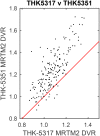In Vivo Comparison of Tau Radioligands 18F-THK-5351 and 18F-THK-5317
- PMID: 27856627
- PMCID: PMC5425312
- DOI: 10.2967/jnumed.116.182980
In Vivo Comparison of Tau Radioligands 18F-THK-5351 and 18F-THK-5317
Abstract
This study compared the in vivo imaging characteristics of tau PET ligands 18F-THK-5351 and 18F-THK-5317 in the context of Alzheimer disease (AD). Additionally, reference tissue distribution volume ratio (DVR) estimation methods and SUV ratio (SUVR) timing windows were evaluated to determine the optimal strategy for specific binding quantification. Methods: Twenty-eight subjects (mean age ± SD, 71 ± 7 y) underwent either dynamic 90-min 18F-THK-5317 or 18F-THK-5351 PET scans. Bland-Altman plots were used to compare the simplified reference tissue method, multilinear reference tissue method (MRTM2), and Logan reference tissue DVR estimates and to assess temporal stability of SUVR windows using cerebellar gray matter as a reference region. In vivo kinetics and DVR estimates were directly compared for 10 subjects who underwent both 18F-THK-5317 and 18F-THK-5351 PET scans. Results: THK-5351 exhibited faster cerebellar gray matter clearance, faster cortical white matter clearance, and higher DVR estimates in AD tau-associated regions of interest than THK-5317. The MRTM2 method produced the most reliable DVR estimates for both tracers, particularly when scan duration was shortened to 60 min. SUVR stability was observed 50-70 min after injection for both tracers. Parametric images revealed differences between MRTM2, Logan, and SUVR binding in white matter regions for THK-5317. Conclusion: THK-5317 and THK-5351 show promise for in vivo detection of AD tau. THK-5351 has more favorable pharmacokinetics and imaging characteristics than THK-5317.
Keywords: Alzheimer’s disease; THK; positron emission tomography; quantitation; tau.
© 2017 by the Society of Nuclear Medicine and Molecular Imaging.
Figures






References
-
- Braak H, Braak E. Neuropathological stageing of Alzheimer-related changes. Acta Neuropathol (Berl). 1991;82:239–259. - PubMed
-
- Thal DR, Rüb U, Orantes M, Braak H. Phases of Aβ-deposition in the human brain and its relevance for the development of AD. Neurology. 2002;58:1791–1800. - PubMed
-
- Braak H, Thal DR, Ghebremedhin E, Del Tredici K. Stages of the pathologic process in Alzheimer disease: age categories from 1 to 100 years. J Neuropathol Exp Neurol. 2011;70:960–969. - PubMed
-
- Guillozet AL, Weintraub S, Mash DC, Mesulam MM. Neurofibrillary tangles, amyloid, and memory in aging and mild cognitive impairment. Arch Neurol. 2003;60:729–736. - PubMed
Publication types
MeSH terms
Substances
Grants and funding
LinkOut - more resources
Full Text Sources
Other Literature Sources
Medical
